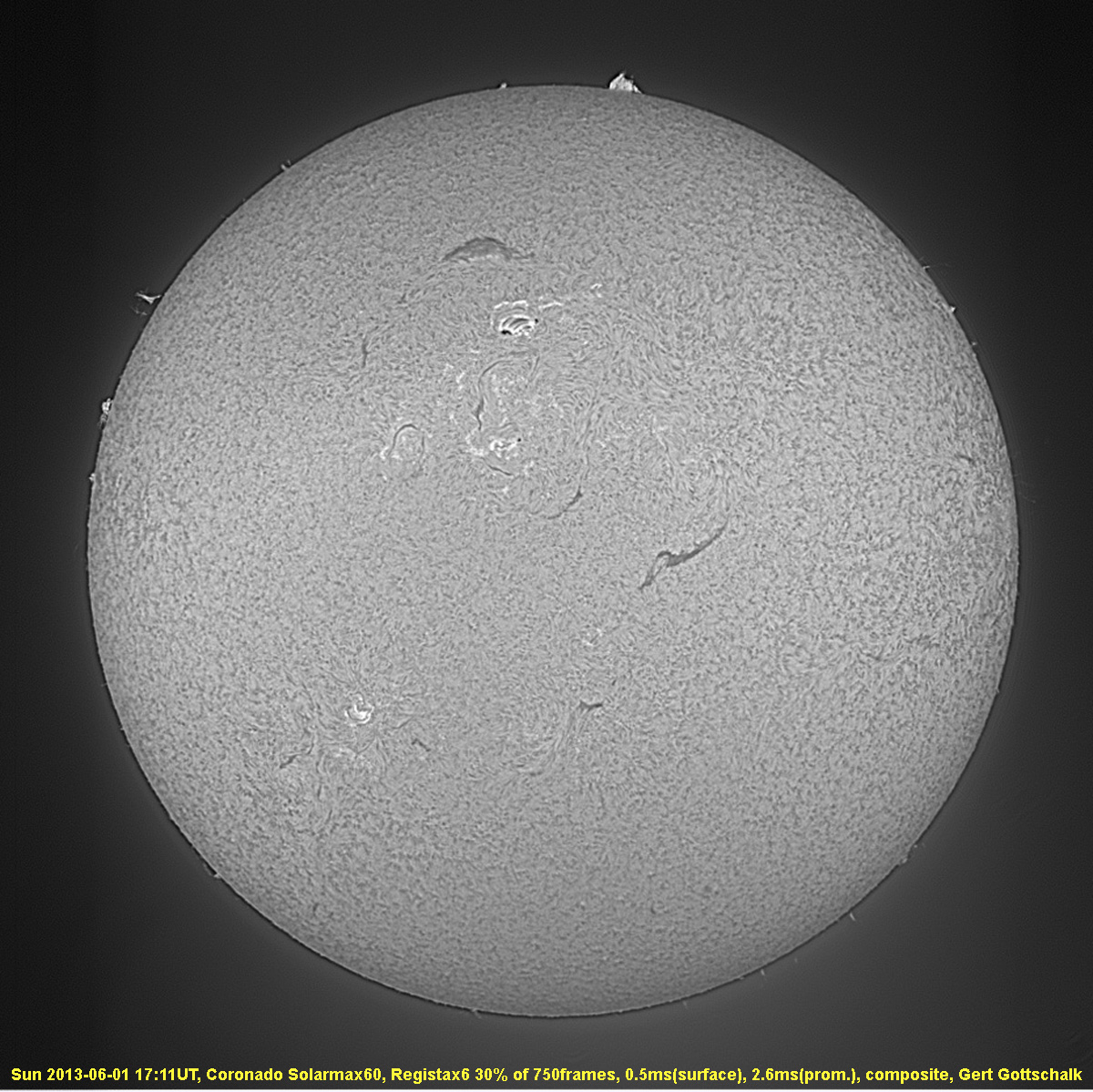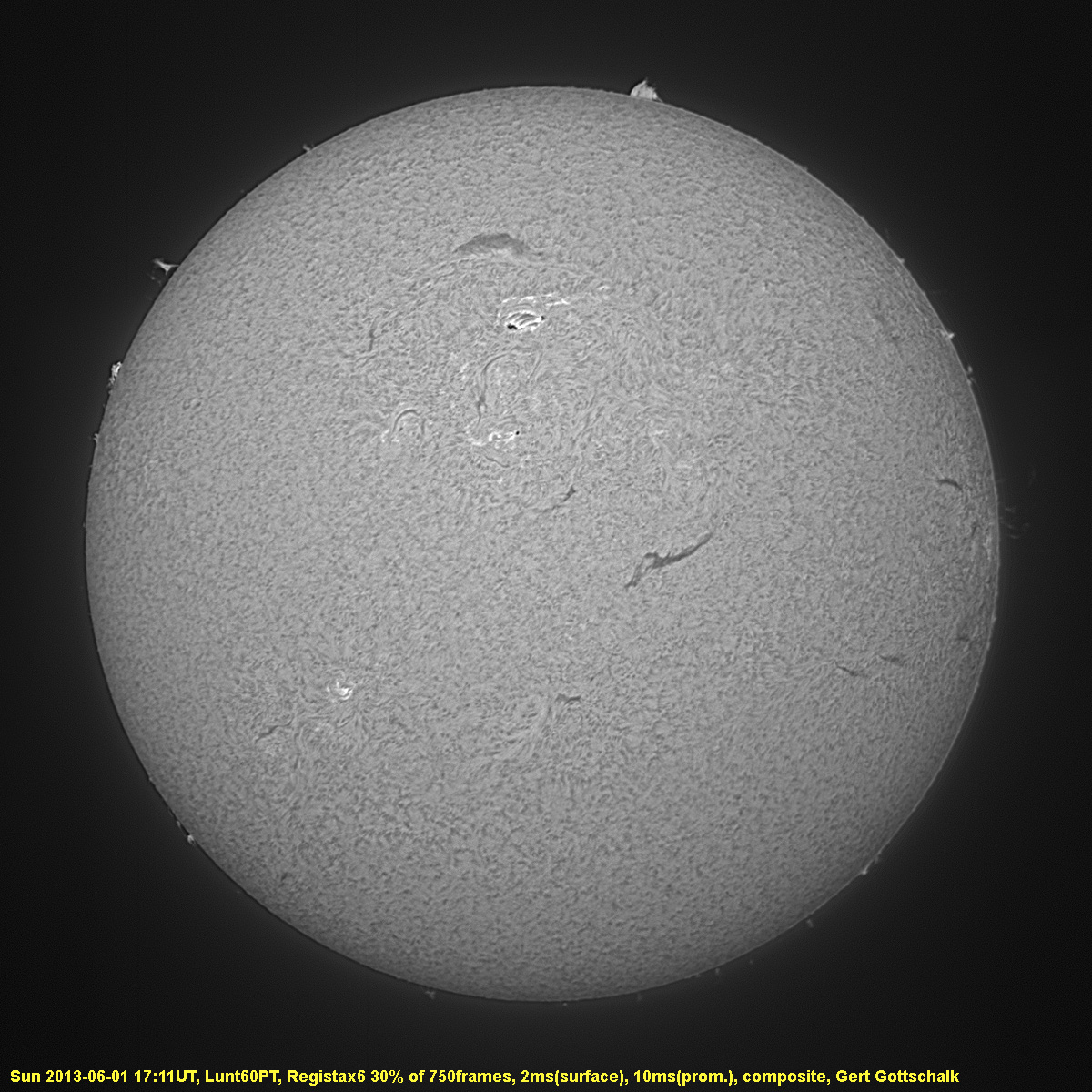Last weekend I had the chance to borrow a Coronado SolarMax60 scope from our astronomy club. This scope is normally used for daytime public events. This gave me the rare opportunity to compare it side by side with my own Lunt60PT H-Alpha scope.
It was a real privilege to have these fine instruments side by side
and compare them on the H-Alpha sun.
The Coronado is a tilt tuned front mounted etalon with 60mm clear aperture.
This means that the H-Alpha tuning of the etalon is accomplished
by tilting it. The more it is tilted the more the center wavelength is
shifted to the blue part of the spectrum. In the flat position the center
wavelength is a bit on the red side of H-Alpha and by turning a wheel on
a threaded bolt the etalon is slightly tilted until the H-Alpha line is
centered. Further tilting will exit the H-Alpha line to the blue. (more
on that later) An energy rejection filter is in front of the actual etalon
and thus serves as a protection to the sensitive filter element. The eyepiece
end of the scope houses the block filter which allows only the H-Alpha
line to pass. All higher and lower order maxima of the interference filtering
taking part in the etalon are removed. On in the end only the narrow H-Alpha
line is passed to the eyepiece or camera.
The block filter is housed in a 90deg prism which also makes the observing
posture more convenient. A 1.25inch holder is attached to the block filter
to hold eyepiece or camera. One observation here. The 1.25inch holder is
a bit too short to fully capture my camera's nose piece or Nagler type
eyepieces. So these stick out a bit and are not held as solidly as would
be possible. There is also a chance of an angle misalignment due to the
short clamping. The clamping is done by a single Nylon thumbscrew.
The Coronado has a helical focuser which is solidly connected to the
block filter. It is not possible to disassemble the scope under normal
condition. This is a great safety feature in public events as it assures
that nobody can accidentally look into the unfiltered sun with the scope.
Coronado with DMK41 cmaera
The Lunt60PT scope uses a glass front lens in combination with an internal etalon. The energy rejection filter is part of the etalon so the front lens element is clear tot he eye. In this configuration the eltalon is also protected from the environment as it sits in the body of the scope. My version of the Lunt60 has the China 1:10 Crayford style 2inch focuser (a Feathertouch version is available). Following the focuser the block filter is again part of a 90deg prism. The block filter can be pulled from the 2inch focuser which might open up the scope for a person to look directly into it. The 1.25inch eyepiece holder of the block filter has 2 metal set screws working on a compression ring. This gives much better locking of the eyepiece or camera nose piece. The 1.25inch holder can be removed and exposes a male t-thread for camera adapters.
Lunt60 with DMK41 cmaera
With identical setting for camera gain and gamma the exposure for the Coronado was 0.5ms, for the Lunt60 2ms. I took care that the top end of the histogram was at pixel count 180. This is odd. The larger image in the Lunt60 would account for a 1.58x longer exposure. But it is actually 4x longer. Thus a factor of 2.53x is missing. This means that 2.53x more light passes through the Coronado when weighted for image scale. It is not clear is the source of this light is in H-Alpha or off-band. One would be desirable the other not.
Here are the two images of the sun after identical processing. Using Registax 6 with 30% frame selection out of 750 frames. (Coronado single frame, Lunt mosaic 2x1 frames vertical). Same settings for wavelet sharpening and contrast adjustment in Registax were used. The Coronado show a bit more brightness 'bleeding' around the sun. Not sure if this is a result of stray light (see above paragraph) Both images show the same amount of detail. The Coronado image lacks a few small low contrast filaments on the right hand side of the solar disk. This is probably an artifact from the incomplete coverage of the sweet spot 'bar' of the disk in this instrument.
Sun with Coronado

Sun with Lunt60

With the tilt tuner the known phenomenon f a sweet spot 'bar' is much more obvious. In my case the 'bar' comes into the video from left to right but then gets stopped abruptly as the tilt range hits the limit. In the pressure tuning system the H-Alpha line 'seeps' into view much more evenly. I have tried to illustrate this my taking videos of both system while tuning. The sequence of the Coronado is 10seconds and it shows coming from the red wing how the sweet spot bar moves into the center and then stops.
The pressure tuner video is 20seconds. I had to perform multiple turns of the tuning handle to move through the range of wavelength tuning.
Copyright images and processing Gert Gottschalk.
Email : drgert1@yahoo.com